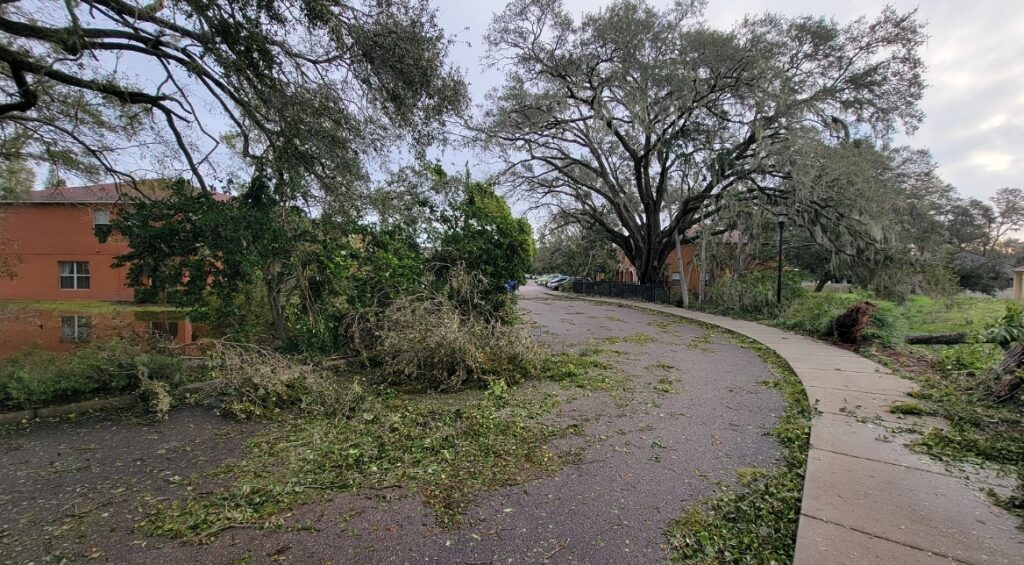In early October, Hurricane Milton worsened an already precarious situation, becoming one of the most destructive storms in recent decades. After reaching Category 5, the highest level on the Saffir-Simpson scale, Milton hit the Florida coast with winds exceeding 250 km/h (155 mph), causing significant devastation. The violent winds, torrential rains, and storm surges resulted in a heavy human and material toll, marking a tragic turning point for the region’s residents.
A Worrying Climatic Context
The arrival of Hurricane Milton occurs against a backdrop of increasingly severe and frequent hurricane seasons in the North Atlantic. Scientists have been warning for years about the link between global warming and the intensification of tropical storms. Ocean warming plays a key role in this phenomenon. Indeed, warmer waters provide the energy needed to fuel hurricanes, thereby increasing their intensity and destructive potential. Recent data show that the average surface water temperature in the Atlantic has reached historic highs. This favors the formation of extremely violent storms.
Hurricane Milton is the second major cyclone to hit the region in less than a month, following Hurricane Helene. Indeed, the last hurricane had already weakened local infrastructure and left many people homeless. This rapid succession of extreme events highlights a growing concern: the tendency to see multiple hurricanes occur within the same season, leaving little time for communities to recover between disasters.
The Hardest Hit Areas
Hurricane Milton made landfall near Siesta Key, a small barrier island on Florida’s west coast. Winds there reached peaks of over 250 km/h (155 mph), uprooting trees, overturning vehicles, and destroying buildings. Pasco, Hillsborough, and Pinellas counties, located nearby, were among the hardest hit by the storm. In Tampa, record rainfall of 280 mm (11 inches) fell in a single day, eclipsing a record of over 100 years. The intense rains caused major flooding that submerged streets and neighborhoods, damaging infrastructure, power grids and communication networks and paralyzing transportation.
In St. Petersburg, the situation was similar, with flash floods devastating homes and disrupting emergency services. Many residents had to be rescued by boat, while hospitals were overwhelmed by the influx of injured people. The material damage amounts to billions of dollars, with thousands of homes damaged or destroyed.
Venice, a city located further south, was also severely affected. The local airport sustained heavy damage, with aircraft overturned on the tarmac and hangars destroyed by the winds. Transportation infrastructure was severely affected, making rescue operations more difficult in the hardest-hit areas. In some localities, road networks were impassable for several days due to debris accumulation, fallen trees, and landslides triggered by the heavy rains.
Devastating Consequences
Milton’s passage resulted in at least 16 deaths, a number that could still rise as search and rescue operations continue in the most isolated areas. The torrential rains not only caused flooding but also triggered landslides, particularly in the state’s hilly counties, forcing authorities to declare a state of emergency in several regions. Relief efforts were hampered by power outages that affected more than a million homes and businesses, depriving many people of heating, lighting, and access to essential services.
Additionally, tornadoes generated by the hurricane caused further destruction. In St. Lucie County, several tornadoes struck the Spanish Lakes residential complex, resulting in fatalities and leaving many residents homeless. Local authorities had to urgently evacuate hundreds of residents to temporary shelters while emergency services worked to clear blocked roads and restore communications.
The material damage is colossal. The roof of Tropicana Field stadium in St. Petersburg was torn off by the winds, causing significant damage inside the structure. In Port Charlotte, rising waters reached up to 4 meters (13 feet), submerging entire neighbourhoods and leaving hundreds of homes underwater. The storm surge was particularly destructive in Punta Gorda. The water rose 1.5 meters (5 feet) in just 30 minutes, trapping residents in their homes and necessitating helicopter rescue operations. Thousands of vehicles were submerged, making travel impossible and exacerbating challenges for relief efforts.
What’s Next for Florida?
The rapid succession of devastating hurricanes such as Helene and Milton underscores Florida’s increasing vulnerability to natural disasters. Experts recommend a thorough review of the state’s infrastructure to better withstand future storms, with a focus on improving drainage systems to prevent flooding and constructing higher seawalls along the coasts. Strengthening building codes for residential and commercial structures to resist extreme winds and flooding is also advised.
As climate change is seen as an aggravating factor, local and federal authorities will need to step up efforts to strengthen emergency management strategies. Relocation plans for the most exposed communities, particularly those on barrier islands and low-lying coastal areas, may be necessary. Modernizing critical infrastructure, such as roads and bridges, will be crucial to ensure they can withstand extreme weather conditions.
Finally, Milton serves as a stark reminder of the urgent climate challenge facing Florida, and indeed, the entire world. As ocean warming continues, hurricanes of this magnitude could become the norm rather than the exception. Florida’s future will depend on its ability to adapt and prepare for climate-related challenges by investing in sustainable and resilient solutions to protect its residents and natural resources. Efforts to reduce greenhouse gas emissions and slow global warming will need to be reinforced to prevent the most devastating storms from becoming even more frequent and destructive.










